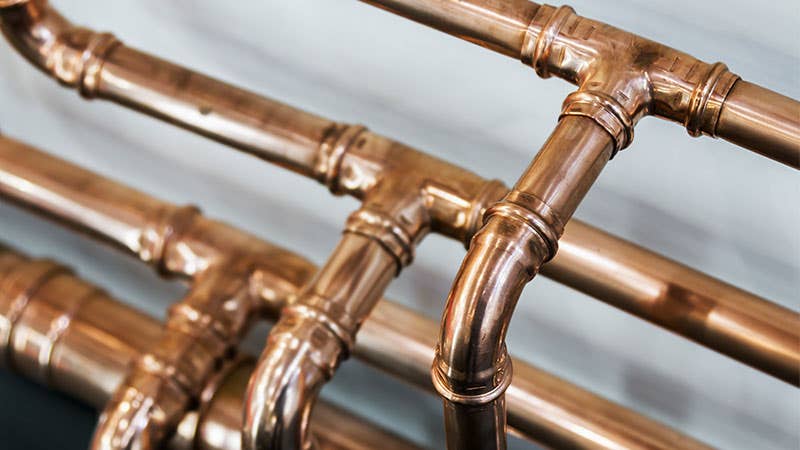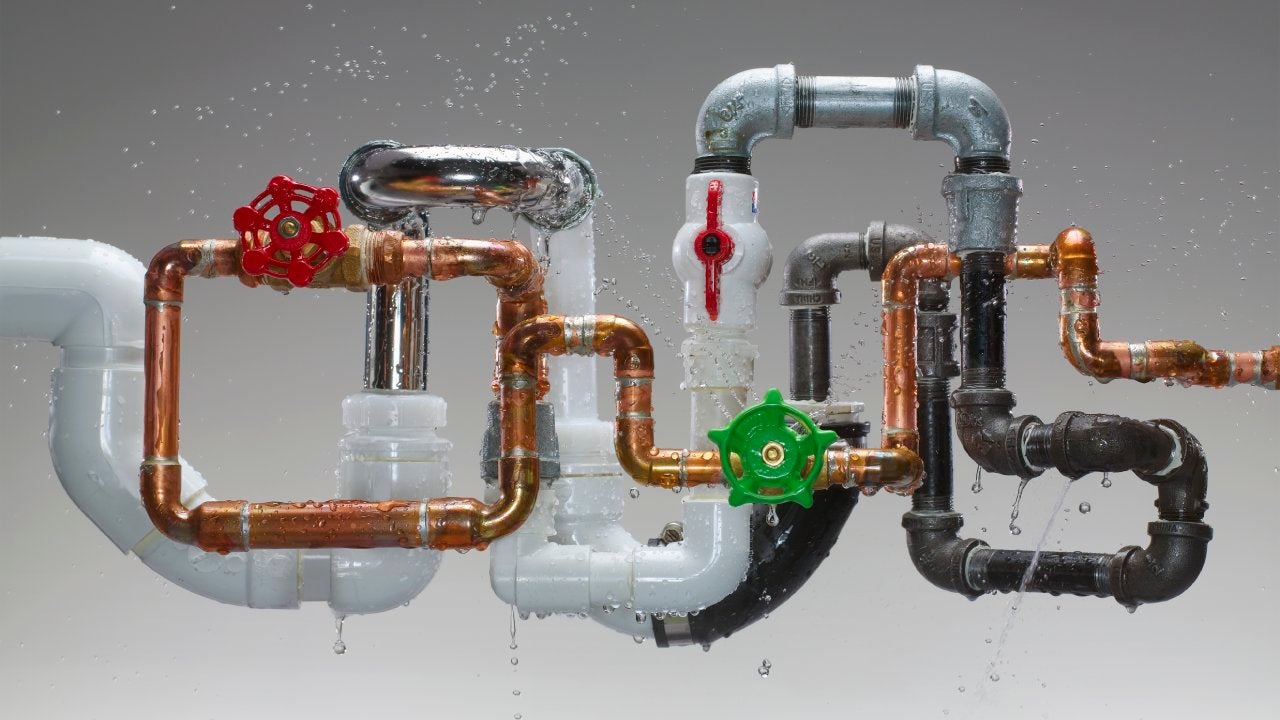How much does it cost to install or replace plumbing?

Plumbing is one of the most important parts of your home — neither you nor most of your major appliances can function for very long without it (think washing, flushing, drinking safe water.)
Fortunately, when it comes to home remodeling projects, plumbing fixes tend to be relatively affordable, depending on the degree and scope of the job and materials required.
The national average cost to install a plumbing system is $4,080, according to HomeGuide. Of course, the overall expense can vary greatly, depending on the parts you need and whether you’re replacing a current system or installing an entirely new one. Most plumbing projects run within a range of $2,280 to $5,120, though extensive repiping or rerouting jobs can go up to $15,000.
If you don’t have the cash to cover, financing options are available. But first, it’s a good idea to understand the costs to plumb a house, as the pros say: the factors that impact the price, the prices of different parts and tips on saving.
Key takeaways
- Most plumbing projects run within a range of $2,280 to $5,120, with the national cost to install a plumbing system averaging $4,080.
- Home size and layout, type of piping material, and whether it’s a new install or repiping job all affect the cost of a plumbing project.
- Changes in water quality or pressure, slow drainage, leaks and noises all can be signs of plumbing problems.
- Even if the costs seem onerous, plumbing repairs or replacements are not something you should put off, and there are several ways to finance them.
Calculating the cost to plumb a home
Plumbing job costs are often calculated on a per-foot basis. In new construction, the national average for installing plumbing is $4.50 per square foot, according to HomeGuide. So, multiply your home’s square footage by $4.50 to get a rough sense of the overall cost. If you only need to replace the current pipe system (“repiping a house,” in industry lingo), the cost drops significantly: $0.40 to $2 per linear foot.
Of course, what you will actually pay for a plumbing repair, installation or replacement can differ significantly based on various factors, including the scope of your project, the amount of plumbing work required, the materials needed and where your home is located.
What affects home plumbing costs?
“On average, plumbing repair costs are about $325 per job. However, it can cost anywhere between $175 and $4,000, depending on what needs to be repaired or replaced,” says Mallory Micetich, a home expert with Angi.
Here are some of the most significant factors that impact home plumbing costs.
Labor costs
The overall price tag of your plumbing project will be greatly influenced by the labor expenses involved. The number of workers required for the project will directly impact the price you’ll pay. Additionally, more intricate and complex jobs that demand specialized expertise will come with a higher price tag. According to HomeAdvisor, a professional plumber typically charges between $175 to $450 for many jobs, with the average cost per hour spanning $45 to $200.
Size of the home or project
The scale of your project will directly influence the associated costs. “Larger homes or extensive plumbing projects require more labor, which can drive costs up quickly,” says Kerry Sherin, consumer advocate with Ownerly. Not surprisingly, replumbing an entire home will involve significantly higher expenses compared to a single room or floor. The size of your house and its layout also plays a role in determining the price.
New build vs replumbing
The cost of plumbing a new construction project versus repiping an existing house can vary significantly. In general, it costs less to install the same length of the same plumbing material in a new build because there aren’t obstructions such as drywall and insulation in the way. When you have to repipe a house, you have to get through those obstacles to access the plumbing, which takes more time and work.
“On a repipe, it’s not so much about the actual piping job you are paying for. In many cases, most of your money is going into the planning, prepping, layout and repairing after the pipes go in,” says Bradley Arnold, founder/president of BACS, Inc., a Kingsport, Tenn.-based renovation and plumbing contracting firm.
Type of pipes
Pipes constructed from brass, copper, and galvanized steel are recognized for their extended lifespan, but they do come with higher upfront costs. Additionally, these types of pipes are rigid, which makes their installation a time-consuming process.
However, if you wish to reduce the expense of repiping your house, you can consult your plumber about using either PVC (polyvinyl chloride) or cross-linked polyethylene tubing, commonly known as PEX. PEX is a flexible, plastic-based tubing that can be employed to replace sections of your plumbing system. It is more cost-effective initially and can be installed more swiftly compared to other pipe materials, as it is easier to thread through walls, thereby minimizing labor costs.
That said, PEX has only been widely used for about a decade, so the jury is still out on how long it will last.
Number of fixtures
Your costs are also affected by the number of fixtures you are installing or replacing. “Each fixture – a sink, toilet, shower or faucet – has unique connections and plumbing requirements. More fixtures mean more materials, labor and time,” Matt Little, a plumber with Sydney-based Damien McEvoy Plumbing explains.
How to know it’s time to repair your plumbing
“If your plumbing is acting differently, it may be time to repair or replace it,” suggests Micetich. “Keep an eye out for clogged drains, gurgling sounds, abnormal water pressure and abnormal water temperature. Other indicators can point to a larger plumbing problem, including a burst pipe, sagging ceiling, smells coming from your garbage disposal or no water coming from your faucets.”
Be on the lookout for the following warning signs.
Water quality
If your water tastes, smells or looks different, your plumbing could be in trouble. If you observe any yellow or brown discoloration in your water, it is crucial to promptly contact a plumber. This color change could potentially indicate the presence of rusty pipes. Taking immediate action is worthwhile because neglected pipes have the potential to burst, leading to costly water damage. It’s also unhealthy to drink water with rust residue.
“If your water smells bad, it could also indicate that bacteria are growing in your pipes,” cautions Little.
Water pressure
Watch the way your water is streaming — if the flow is suddenly slower or faster. Robert Jenkins, a plumber in Eugene, Oregon, points out that low water pressure — the water coming out in a trickle — is a good indication of a clog in a water liner fixture, usually from sediment in your pipes. “High water pressure is much less common but a guaranteed indicator of plumbing problems in the near future,” he continues.
Leaks
Leaks are among the first and most visible signs that your plumbing system requires attention. Dampness, mold growth or water stains on your walls, floors or ceilings can all be evidence of a leak.
You can also keep an eye out for water leaks as a way to evaluate the state of your plumbing. Start by finding your water meter and writing down the initial reading. Then, make sure that no water is utilized in your home for a period of two hours. Once the time has elapsed, check the meter reading once more. If the reading has altered, there is probably a leak present within your plumbing system.
Outdated pipes
Old pipes made of galvanized steel, polybutylene or similar materials are vulnerable to rust, corrosion and leakage. If you are experiencing frequent plumbing issues or observe signs of corrosion, have your plumbing system inspected and consider replacing your pipes and connections with more durable materials, if recommended.
“Galvanized plumbing should be replaced after a minimum of 20 years up to a maximum of 50 years,” Sherin advises.
One way to learn if your pipes are outdated and need maintenance is by examining the visible pipes in locations like your attic, basement, and utility areas. Look for signs of corrosion, such as discoloration, or minor dents.
Additionally, note that your home’s pipes may be made of lead – which has been prohibited in the United States since 1986 – especially if your home was built in the mid-1980s or earlier. If so, your family could be ingesting small amounts of lead through your tap water, which can lead to various health issues. To check, get a water testing kit, which can reveal if your household water contains lead. If your kit reveals a positive test, consider upgrading your plumbing system as soon as possible. This is particularly crucial if you plan on selling your home: Discovering lead pipes during a home inspection could deter potential buyers.
Clogged or slow drains
Notice slow drainage in your bathtub, sink or toilet? These are telltale signs of a clog, likely caused by the buildup of dirt, minerals and/or grease in your pipes.
Minor clogs can be easily remedied with a chemical drain cleaner purchased at home improvement stores or by using a drain snake. “But if your system is outdated, clogs could be a sign of corrosion on the pipe walls that are hanging on to solid waste, which would generally warrant a re-piping,” says Arnold.
How to plan for plumbing installation
If the plumbing project is on a new home or room, the only thing you’ll need to worry about is the cost. If you’re replumbing your current home or existing area, there is more than just the cost of the plumbing job to consider. You will need to prepare for the work and the impact it will have on your daily life.
If your entire house is undergoing plumbing work, you will essentially be residing in a construction zone for a while. Although your plumber will strive to minimize disturbances, it is almost impossible to completely eliminate the presence of noise, wall openings, dust and debris. So, you should prepare by moving valuables and electronics and covering furniture.
The plumbing project will also likely need the water to be shut off for at least a couple of days. You may need to make alternate arrangements, such as checking into a hotel or staying with friends or relatives.
Cost estimates for plumbing projects
Plumbing projects encompass a variety of parts, and you’ll pay a different price to replace a water heater than to repair a sump pump. Here are common plumbing repairs and their average prices. Bear in mind that the plumber or company you choose, as well as local labor costs, will impact the overall expense.
| Project | Average cost |
|---|---|
| Source: Angi/HomeAdvisor | |
| Bathroom clog repair | $200 |
| Toilet repair | $250 |
| Toilet replacement | $400–$10,000 |
| Leaking pipes | $250 |
| Faucet replacement | $250 |
| Bathroom sink pipe repair | $300 |
| Kitchen sink clog repair | $300 |
| Garbage disposal repair | $400 |
| Dishwasher repair | $300 |
| Water heater repair | $550 |
| Septic tank repair | $1,500 |
| Sewer main repair | $3,000 |
| Main water line repair | $350–$1,625 |
| Drain line repair | $700 |
| Sump pump repair | $300–$700 |
DIY vs hiring a plumber
The experts agree: It’s best to hire a pro for most plumbing jobs if you want to play it safe and avoid serious water damage – especially if you lack a DIY background.
“When customers ask, ‘Can’t I do this?,’ I answer, ‘Is it beyond the shutoff valve?’” says Arnold. “Each fixture will have shutoff valves – one hot, one cold – to isolate it from the rest of the plumbing system. Anything past the shutoff valve, such as changing a spray nozzle, I consider to be DIY-friendly because the water can be easily shut off until a professional can get to your home if anything goes wrong. Just understand the consequences of making a mess; if things go wrong, it can take the plumbing professional longer to fix what you did wrong.”
Tips to save on plumbing costs
While the material prices are pretty fixed, there are ways to minimize costs when replumbing your house:
- Be proactive: Don’t wait until you have a watery disaster on your hands. Regularly inspect your pipes to catch any potential issues early, and get help as soon as you spot anything off. Plumbing problems rarely clear up on their own, and addressing them sooner rather than later can minimize the repair work. A plumber responding to an emergency is going to be more expensive than a plumber on a scheduled job, too.
- Set your plumber up for success: “Make it as easy for the plumber as possible. For example, clear out all the items beneath your sink or move stuff away from the crawlspace. Tidy up the area they will be working in so they won’t have to move your stuff for you,” suggests Jenkins. Limiting the number of labor hours will keep your overall costs down.
- Ponder piping options: Compared to traditional metal, PEX and CPVC piping are generally cheaper upfront and easier to install compared to metal piping options. If cost is a concern, opting for these alternatives can help keep expenses in check.
Financing options for plumbing costs
Extensive plumbing installations or replacements can be challenging financially if you’re not ready for them. However, there are alternatives to cover the costs without dipping into your savings or running up a big credit card balance. Consider the following strategies for financing major plumbing repairs:
Personal loan
Most banks and lenders offer personal loans for major renovations, also called home improvement loans, as long as you have decent credit and a source of income. Personal loans have a fixed interest rate and a repayment period between 12 and 60 months. The better your credit, the lower your interest rate. Since personal loans are also often approved in a short time, they can be ideal if your plumbing problems are urgent.
Home equity loan
If your plumbing project runs into the five figures, opting for a home equity loan can be a viable solution. Compared to personal loans, a home equity loan offers a longer repayment period and typically lower interest rates (the terms are more generous since your house serves as collateral for the debt). Additionally, the interest paid on a home equity loan may be tax deductible.
Home equity line of credit (HELOC)
A HELOC operates similarly to a home equity loan but provides you with a revolving line of credit instead of a fixed sum. This option is suitable if you plan to tackle your plumbing project in stages and want to pay for it incrementally. With a HELOC, you can borrow as much or as little as you need, paying interest only on the outstanding balance — making it convenient if you’re unsure of the overall costs of the project.
The bottom line on installing or replacing plumbing
Ultimately, the cost to plumb a house depends on factors unique to the home itself and its existing plumbing. New plumbing can be costly, but it doesn’t have to be a punch to the financial gut if you’re smart about exploring your financing options.
Don’t cut corners on the plumbing if you’re building a new home, adding an extension or finishing a basement. You’ll want it to last decades before any replacements or repairs are required.
And if you have to repipe your house? Even if the costs seem onerous, plumbing repairs or replacements are not something you should put off. If you do, you may find yourself in hot water — or rather, you won’t.
Additional reporting by Erik J. Martin
You may also like

How to get a business loan with an LLC

How much does it cost to replace your home radiator?

Which plumbing pipes cost the most money?



